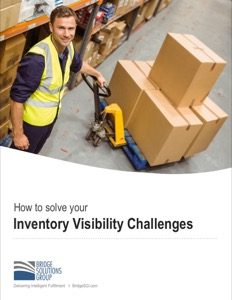In-Store Pickup Change Management: 35 questions to get you started
June 27, 2018 by The Bridge Solutions Group Team

When she gets to the store to pickup her online order, will the pickup experience inspire additional purchases?
57% of online shoppers said they had picked up an online order in a store in the last year according to results of a study published in August 2017. And in-store pickup is a great way to drive traffic into stores. In fact, 71% of customers will make an additional purchase while in the store.
But if your customers have an unsatisfactory in-store pickup experience, there’s a good chance they’ll skip the additional purchases, which will impact the return on your Buy Online Pickup In-Store (BOPIS) investment. So, in this article, the second in a series that started with Buy Online Return in Store: 15 change management questions to consider, we’ll cover some change management questions that will help you craft a high quality pickup process.
To make it easier, we’ll align the question with the 3 different approaches to Buy Online Pickup In-Store, in order of complexity:
- Ship to store from Distribution Center (DC)
- Drop ship to store from third party vendor
- Pick order from store inventory
Ship to Store from Distribution Center (DC)
This is the simplest model. Orders are shipped directly to store, from the DC, pre-labeled with the customer’s information. Store associates do not have to pick orders, so business disruption is minimized. Key change management questions include:
- In the DC, how will warehouse employees package items being shipped to a store for pickup?
- Where will store pickup orders be staged in the DC?
- How will store associates know which inventory is designated for a customer? Will they be labeled so they’re easily identifiable?
- Will they be shipped to the store with store replenishment orders? Or separately?
- Where will store associates stage store pickup orders once received?
- How will customers know where to go to pickup their order in the store? What signage will stores need?
- Will the store associated process the pickup confirmation via the Point of Sale system? Online? Via a mobile device?
- How many pickup orders can the store handle per day? Will additional labor be required? What is the anticipated volume increase during peak season or promotions?
- How do you handle abandoned orders (those not picked up by the customer)?
Drop ship to store from third party vendor
Drop shipping is a popular way for retailers to provide an expanded assortment without owning the inventory. Drop ship to store offers this same inventory expansion, but with the added benefit of driving store traffic. It works particularly well when the drop shipped item is part of a bundle of products ordered by a customer, for example:
- Accessories to complement an outfit
- Custom helmet to go with a new bicycle, or
- Specialized accessories for a new mobile phone or computer
This way, the customer visits the store once and receives all their items at the same time. But to successfully receive in-store pickup orders from multiple sources (which may have inconsistent packaging and labeling) requires some additional thought. Change management questions for this use case include:
- How should third party vendors label orders so they’re easily identifiable? Can this be standardized?
- If the items are part of a larger order that needs to be consolidated, how should this be indicated?
- Where should store associates stage items awaiting consolidation?
- How will store associates be notified when all items in an order have arrived and are ready to be consolidated?
- How do you handle abandoned drop ship orders (those not picked up by the customer)? Should they be returned to a single location for sorting? Or shipped directly to the drop shipper?
Pick order from store inventory
This is where things get tricky. Why? Because, while inventory accuracy in a well run DC is usually good, stores are a different matter.
Inventory moves from the backroom to selling floor, rides in carts, is abandoned in fitting rooms, or placed on random shelves by customers. And whether your revenue is $200 million or $12 billion, the number one challenge when fulfilling orders from store inventory, is inventory accuracy. Without it, you’ll have canceled orders which result in customer disappointment, and lost sales. So when you start preparing to pick orders from store inventory, consider how best to achieve the inventory accuracy you’ll need to ensure success. Some important initiatives to consider include:
- Implement real-time (or near real-time) sync of Point of Sale (POS), Order Management, Warehouse Management, eCommerce, and ERP systems – if not for every SKU, at least for high velocity SKUs.
- Assign ‘Safety Stock’, or a number of units of a given item below which an ecommerce order is not sent to a store to fulfill.
- Have store associates conduct cycle counts of store inventory, just like in a warehouse.
- Using RFID to track inventory.
Other change management questions you’ll want to address are:
- How will store associates be notified that an order is ready to pick? Via the POS? A mobile device? Printed pick ticket?
- What system will store associates use for picking?
- Can the system provide the item location (do you have standardized store planograms)?
- How will associates pick orders? By product? By order?
- Will associates pick orders from the floor, the backroom, or both?
- If an item is out of stock, and a store associate enters a ‘no pick’:
- Does the system send an alert to check in the backroom?
- Will inventory availability be updated to prevent future customers from ordering this out of stock item as well?
- What is the planned placement/setup of merchandise that is pending pickup? How will it be organized?
- How will store associates indicate an order is ready for pickup?
- How will the pickup be processed in the store? Via POS? Mobile device?
- How will customer communications be managed? (e.g. Order ready for pickup, Order not picked up, or Order can’t be filled)
- What is the escalation process for orders not picked? What alerts are needed and who receives them?
- Do you want to limit the number of BOPIS orders that can be fulfilled by a store within working hours?
- How do you handle abandoned orders (Customers Not picking after the Order is ready for Customer Pickup)? Will the order be canceled and the items restocked after a certain period? If so, what is the process for canceling an order due to no pickup?
- What is the current associate utilization in the stores? Will additional labor/time and dedicated resources be required? What is the maximum number of orders a store can process per day?
- If inventory is not available, do you want to provide substitutions? If so, how will store associates ask a customer if a substitution is ok?
- Do you want include display stock in the ‘available inventory’ for pickup orders? If not, how will you exclude that inventory systematically?
- Do store associates scan inventory when moving it from the backroom to the floor to ensure inventory location is accurate?
- What cycle count/inventory adjustment capabilities exist in stores? Should store associates do an item count each time they pick an order?
- How well-established are the lines of communication between the e-commerce and store teams relative to promotional activity (e.g. how will stores be notified of upcoming online promotions that will impact BOPIS volume?)
- Who will determine safety stock levels? Store managers? Planning and allocation? Supply chain?
- What metrics will be used to measure in-store pickup success? Orders processed per store? Orders processed per associate? Pick turnaround time? Order accuracy? How will you incentivize store associates to pick orders quickly and accurately?
As you can see, in-store pickup has some complexity. But it’s a great stepping stone on your journey to offering ‘Ship from Store’ after Buy Online Return In-Store. And with ‘Ship from Store’ you can fully leverage all your inventory across your entire store network to fulfill online orders. This let’s you minimize markdowns and reduce inventory carrying costs. In the next article in this series, we’ll look at some Ship from Store change management questions. In the meantime, if you’d like to learn more about BOPIS change management, please Contact Us.
Filed under: Blog, Omnichannel, Supply Chain



 For FREE insights into how to improve your supply chain, simply enter your contact information for access to our entire library of eBooks, whitepapers and data sheets.
For FREE insights into how to improve your supply chain, simply enter your contact information for access to our entire library of eBooks, whitepapers and data sheets. You'll be missing out on access to hundreds of pages of supply chain industry ideas and insights that will make you look great in your next meeting.
You'll be missing out on access to hundreds of pages of supply chain industry ideas and insights that will make you look great in your next meeting.